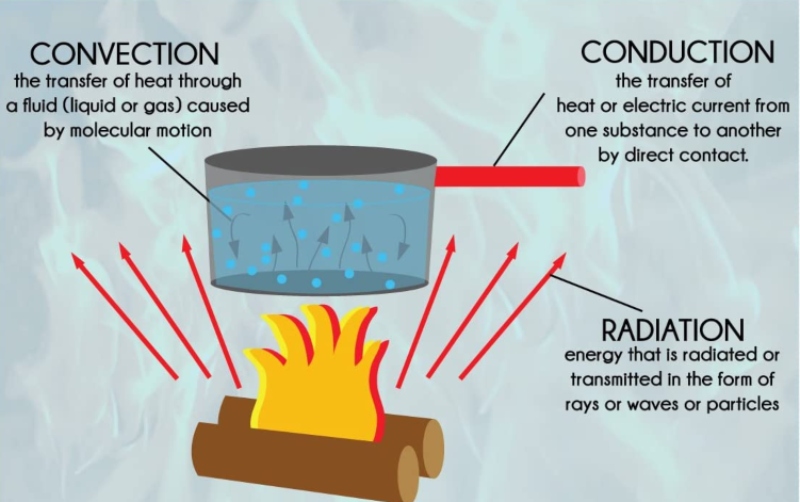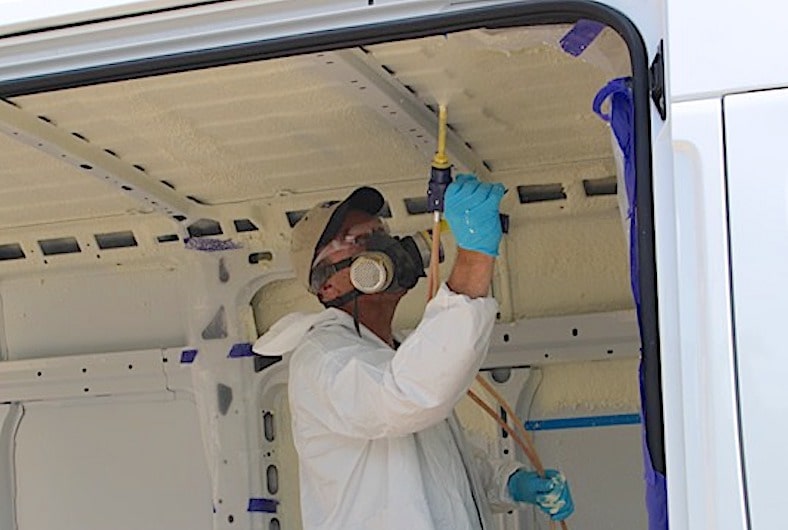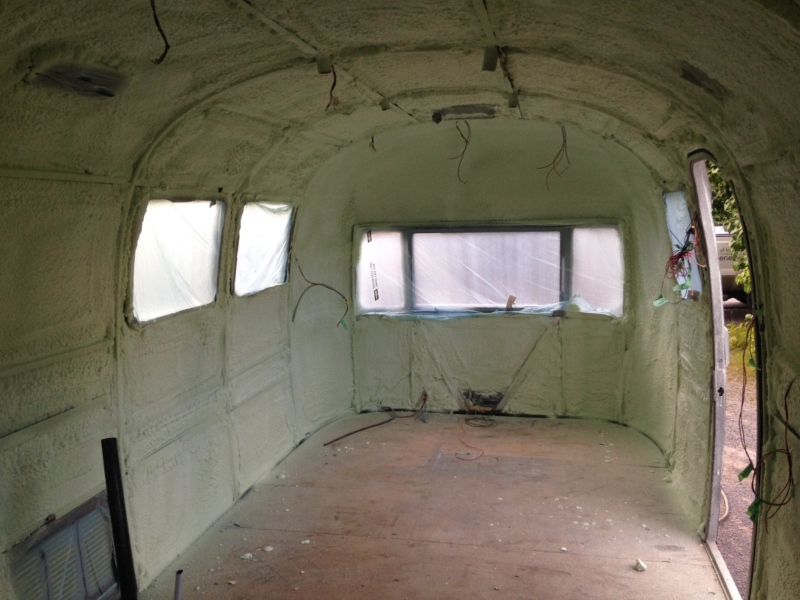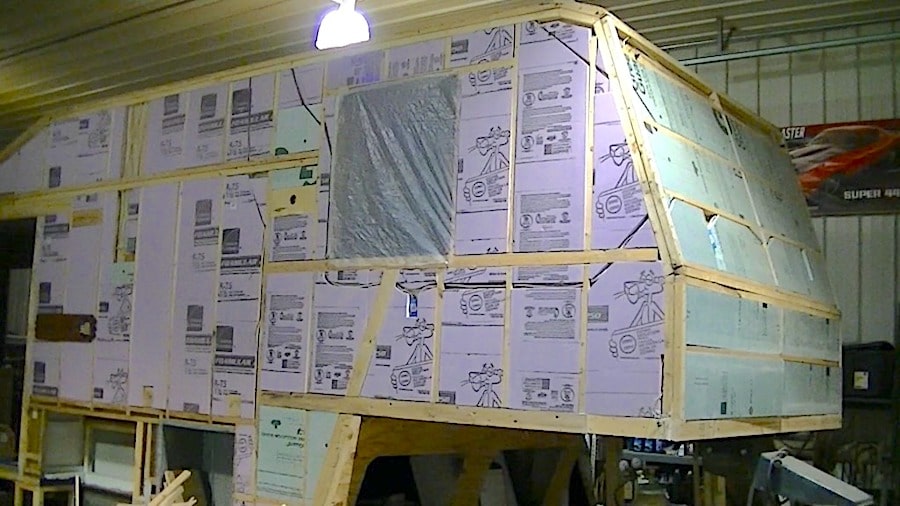Thanks for your support! If you make a purchase using our links in this article, we may make a commission. And, as an Amazon Associate, I earn from qualifying purchases. See the full disclosure here.
When you go camping for the weekend, isn’t it a great feeling to plug into shore power and not have to worry about an electric bill? At one point or another, part-timers come to this realization and quietly smile to themselves. During the camping season, they crank up their RV air conditioners without considering RV insulation or R-value.
For full-timers, it’s a different experience. A lot of these RVers are required to pay for electric service monthly. Unless you have a solar system that can feed your A/C’s appetite, over half of your electric bill is consumed just by climate control.
Understanding how RV insulation works is the key to reducing your climate-control costs. To do that, we’ll explain how insulation works and what R-value means. With this key knowledge, you’ll become a master RVer who can beat the summer heat and live like royalty in the coldest of winters.
What Does R-Value for RV Insulation Mean?
If you remember Peter Sellers as Inspector Clouseau, you’ll remember the Pink Panther Owens Corning commercials of the 1980s and 1990s. Owens Corning recommended that you have at least a 12-inch layer of their R-25 insulation to protect your home properly. Unless you owned a set of Encyclopedia Brittanica, you had to assume it was a good rating.
RVs of that time period mainly used fiberglass batt insulation but were nowhere near R-25. If you had R-7 insulation in your RV, you were lucky. Only experts in insulation who could build their own coach from the ground up had a chance of extending their RV season beyond Halloween.
An insulating material’s resistance to conductive heat flow is measured or rated in terms of its thermal resistance or R-value — the higher the R-value, the greater the insulating effectiveness. The R-value depends on the type of insulation, its thickness, and its density.
United States Department of Energy (DOE) definition of R-value
In our physical world, heat always moves towards cold. It does this until the temperature is balanced. The key to R-value is minimizing the thermal conductivity of insulating materials.
To translate all of this into “RV Speak,” R-value is a measurement used for insulation. The higher the number, the better your coach retains/resists heat. The R-value of air is R-1, while a thick layer of densely packed fiberglass batt can have an R-value of R-25.
We would love to have R-25 values on our RVs, but the technology isn’t there yet. Most RV manufacturers use dense polyfoam block foam insulation that ranges between R-5 to R-7 in their RV sidewalls. All-season/four-season travel trailers increase their insulation depending on the RV maker.
Insulation aims to prevent or minimize heat transfer to the colder temperature. In the summer, think of the outside air as that invading medieval army trying to break into your castle with a battering ram at your castle gates. The R-value would be the strength of your gate (insulation), keeping the invaders out.
Resistance Isn’t Futile: How Heat Transfers Through RV Insulation

The DOE’s definition of R-Value talks about resistance to the conductivity of heat flow. There are actually three different ways insulation works, two of which create R-Value.
- Conduction: A relevant definition of conduction is the process where heat transmits through a solid material when there’s a temperature difference. Most metals, graphite, and some plastics are conductive. Using fiberglass batt or foam insulation stops heat transfer from the inner to the exterior walls of your RV.
- Convection: Heat circulates air as it transfers to colder temperatures. According to master home builder Bob Vila, you want to contain a layer of air near a heat source, allowing the heat to transfer throughout the space. Using Bob’s definition, your insulation’s R-value keeps the convection effect inside your RV, dissipating the heat (or air conditioning) within the coach instead of leaching outside.
- Radiation: Radiant heat (like the sun) travels in a straight line and warms anything solid in its path that absorbs energy. Using reflective air bubble sheeting on your windows and doors doesn’t increase your R-value directly. It does reflect ultraviolet radiation and other radiant heat sources from transferring inside.
Other Ways to Enhance the R-Value of Your RV
Insulation with a high R-value can effectively slow conduction and convection. If you have reflective sheeting on your windows, you’re further protecting the interior of your RV from heat transfer. Yet heat can be sneakier than a cockroach.
Sealing the Cracks
You want to ensure your heat vents are closed and secured during the summer. Conversely, your air conditioner ducts should be sealed during the winter. Slideout edges should be inspected and covered with door draft stoppers or other draft-preventing materials.
Even if your ducting is insulated, you’re wasting climate-control energy keeping these unneeded ducts temperature controlled. Sealing these vents will not only increase your R-value, but the interior of your RV will also reach your desired temperature faster and more efficiently.
Moisture Control
Moisture in the air doesn’t affect your R-value, but it does affect your energy costs. Humid air takes more energy to cool than dry air. Water isn’t a conductor of heat, so it takes longer to cool or heat.
This is only part of the issue with humid air. If your RV’s interior is exposed to humid air for long periods of time, this is perfect conditions for mold and mildew to start growing. The wooden infrastructure of your furniture and various other components that aren’t sealed can start to crack or warp.
Your rooftop air conditioner doesn’t have a dehumidifier feature in it, so you may want to invest in a dehumidifier. You’ll see your energy costs drop and elongate the life of your RV. This’ll also save you from having to replace any insulation prone to water-related damage.
3. Common Types of RV Insulation
Now that you have a full tool belt of knowledge concerning what R-value means and how it relates to your RV, we’ll explore the common types of insulation within the RV world. For those do-it-yourselfers (DIY) who are rebuilding their Antique (pre-1944), Vintage (1945- 1970), Classic (1971- 1989), or Neo-Classic (1990-2007) Era coach, this section can help you with your project.
1. RV Foam Block Insulation

Rigid foam is the most popular type of insulation used today. RV manufacturers cut the polyfoam into precisely measured pieces and put them in a heated press with the exterior walls. This process bonds the two pieces to create an airtight seal.
They are then laminated together for further protection against contaminants. These compound pieces are then attached to the aluminum frame with just enough room for wiring, plumbing, and ducting. Before the interior walls are installed, support framing is placed for windows and furniture.
The R-value of rigid foam is anywhere between 3.5 to 6. All-weather/four-season coaches that are built for beyond freezing temperatures have R-values that go up to R-10 in some cases. Insulated bay doors and RV door insulation may have different R-values than the sidewalls.
There are 2 types of rigid foam:
I. Extruded Polystyrene (XPS)
This type is easily recognized by its pink, blue, or green color. RV manufacturers use XPS due to its perfect balance of benefits. It’s thin enough to use in sidewalls, has a medium R-value, is strong, and is cost-effective. XPS is also recyclable.
II. Expanded Polystyrene (EPS)
You’ll recognize this material from the foam ice chests, coffee cups, and other foam products. RV makers place this type of insulation in long bars in the roof of motorhomes and some towables. It has the highest R-value of the three versions, doesn’t degrade, and is most often used in home and building construction.
If you plan on replacing your rigid foam, do your research first. Removing it can be difficult since it’s laminated, heat bonded, and glued to the exterior wall. There’s not a lot of room between your insulation and your interior walls, but you may want to consider adding spray foam insulation which will add to what you already have.
2. Spray Foam RV Insulation

Spray foam is not commonly used as factory-installed insulation. Many DIYers like to use it to add an extra layer of insulation to what they already have. It has the lowest levels of R-value (around R-3.5) but is the easiest to install.
There are a few different types, but expanding polystyrene is the safest to use. If you decide to use spray foam, ensure all of your windows are open and use fans to vent the fumes. You’ll also want to use PPE (personal protection equipment) and thoroughly protect your RV’s interior.
Polyisocyanurate (Polyiso, ISO) comes in a spray can. It sprays out as a liquid and hardens dry. The closed cell version has a higher R-value than the open cell type.
3. Fiberglass Batt RV Insulation

You’ll find fiberglass batt insulation in RVs from older eras to today’s conventionally built wood-framed travel trailers. The problem with RV fiberglass batt insulation is its “magnetism” for moisture, which starts to break down within a year. Fiberglass batt is great for solid-structure buildings, not RVs.
The trade-off is its high R-value. When vintage and early classic RVs came off the factory floors, they had R-values between 13-19. Today’s wood-framed RVs are built much better, but unless they’re kept near hospital-level environments, the insulation degrades, becoming nesting grounds for mold and mildew.
Also, pests looking for warm places to nest will give Fiberglass Batt 5 stars for the luxury accommodations. Some RV brands still use fiberglass batt in wood-framed RVs with corrugated aluminum. To prevent Mr. and Mrs. Rat or Mouse from moving in, ensure you’re keeping up on your RV preventive maintenance, focusing on seals and open spaces.
Do Dryer Sheets Keep Mice Away From RVs and Campers? We wrote an article all about it so please check it out!
RV’s of these time periods have walls that look like houses. You could cut rigid foam into strips that fit within the studs and/or use spray foam. Either one will work well as a replacement.
Before you retrofit your new insulation, definitely check for asbestos in earlier era RVs. Some of these RVs do have this carcinogen in them. The safest way to remove it is to hire experts that have the proper equipment to remove it.
RV Exterior Sidewall Insulation
Did you know that your exterior RV sidewalls have R-values of their own? Materials like Azdel are fiberglass composites that are designed with thermal and sound insulation properties. With an R-value three times better than wood, Azdel has a rating of roughly 4.5.
With the bonding process, the R-value of the wall and the insulation work in concert to create the highest R-value travel trailers. Many major RV manufacturers and their subsidiaries use Azdel in their coaches. Some of them include:
- Forest River
- Jayco
- Lance
- Winnebago
- Gulf Stream
- Heartland
- Nexus
- nuCamp
- Many others
RV Underbelly Insulation
RV floor insulation wasn’t thought of much in previous years. Underneath the subfloor was either metal or wood. When the concept of four-season camping entered into the RV world, using RV insulation in the underbelly was an optional feature.
As it became popular, sealing travel trailer underbellies became a standard feature. RV manufacturers are now using corrugated plastic sheeting to protect and insulate the underbody of RVs. Like the sidewalls, they place a rigid foam layer to work together with this material that has its own R-value.
The black sheeting has an average R-value of R-6. Many people forget how valuable it can be to prevent the summer heat from coming through the floor. It also contains your furnace’s efforts in the coldest of winters.
RV Roof Insulation
Your Roof has a top layer usually made of either a rubber composite or a polyvinyl chloride (PVC) membrane. Underneath that is a thick layer of insulation. Your RV’s roof does most of the “heavy lifting” when it comes to insulating your RV since heat rises, and it’s the one area that’s most exposed to the sun.
Your roof’s insulation is usually between R-10 to R-20. Since it’s thicker than the walls, more insulation is possible. Ensure your A/C evaporators are working properly so the water isn’t overflowing onto your roof insulation.
As a preventive maintenance tip, adding a sealant layer will definitely help when you’re up there checking for cracking. The sealant is a white paint-like material that can be rolled on. It’ll help your roof in the battle against the sun’s radiant heat.
What Is the Best Type of RV Insulation?
In most cases, rigid foam board insulation is the best type of RV insulation that balances benefit and cost. It has a high R-value, holds up to travel, time, and moisture rigors, and isn’t very difficult to install.
Fiberglass batt insulation comes standard in many older RVs, but it’s not the best choice. This type of insulation tends to hold on to moisture and breaks down quickly, causing it to be a breeding ground for mold and mildew.
Spray foam insulation is easy to install but offers a high R-value per square inch, but can become expensive and time-consuming in the installation process. This insulation would be best for fair-weather RVers.
What’s the Best R-Value Measurement?

The best way to measure R-value for your RV insulation isn’t the collective whole. Thanks to one of our readers with an engineering background, you want to learn your RV’s R-value by determining the thickness (in inches) per square foot.
When you compare the various RV insulation types at the square-inch level, you’ll find some fascinating results:
| Foam Type | R-Value per sq. Foot | RV Use |
|---|---|---|
| EPS | R-3.6 sq. foot | Roof/Floor |
| XPS | R-5 sq. foot | Sidewalls |
| Open Cell Spray Foam | R-4 sq. foot | Any |
| Closed Cell Spray Foam | R-7 sq. foot | Any |
Remember, R-value is based on thickness, not length. If a sheet of XPS rigid foam is exactly 1 inch thick, it should have an R-5 value per square foot anywhere you measure it. Theoretically, if another sheet has thin spots, that specific spot will have a lower R-value than the other insulation around it.
If you were to double up the layers of RV insulation, that doesn’t necessarily mean you’ll get twice the R-value. Depending on what you’re using, that value could go beyond that doubled value or not do much at all.
For example, if you were to spray another layer of spray foam on an already-dried layer, the R-value more than doubles.
On the other hand, doubling up an R-5 fiberglass batt insulation doesn’t mean it has the same R-value as a single layer of R-10 fiberglass batt.
To make the best use of RV insulation to increase your R-value, you’ll need to research the insulation material you’re using. Learn how it works and how to use it for optimal insulating values.
Other RV Insulation Ideas
Your RV may have great insulation, but your climate-control devices still work hard to keep the interior space comfortable. Your coach has windows, slideouts, and other components that your insulation doesn’t protect. Our RV window insulation tips feature can help you complete the rest of the equation.
There are other techniques you can use to prevent heat transfer. We already mentioned using door draft stoppers around your slideouts. If you have your choice, try and pick a campsite that’s more shaded. A window awning can be a great way to dampen the sun’s rays.
If you don’t have a rear window, try to park your RV so the front faces north. The southern-facing side of your RV will receive the most direct sunlight. Windows with the most northern exposure get the least amount of sun exposure in the United States.



You should check out Grand Design Camp Trailer Imagine. the put in a all season package and other unique R values that are quite impressive.
I am curious if anyone has used foam board insulation on the outside under the floor of a slide. We plan on traveling in the winter next year to ski and having the slides out would be nice but don’t want to have a tremendous amount of heat loss over something easy to install with velcro. Thoughts? We do plan on doing the AirSkirts for the underside of the RV.
Good guide overall, not many RV centered articles that deep dive into this topic! I will say that there are a few things that I could see being confused about when it comes to R-Value. When you see R-values of 15 or 25, really high ones, for an INDIVIDUAL insulation, that typically means that’s the overall R-value for THAT THICKNESS (typically more than an inch) or when it is put between wood studs like you find in traditional home building.
What you want to look at is the R-value PER INCH of insulation.
When comparing spray foam and rigid foam board, spray foam can be significantly more insulative (depending on the type). Closed-cell spray foam has an R-value/inch of 7 while XPS rigid foam board has an R-value/inch of only 5. Open-cell spray foam on the other hand has an R-value/inch of around 4 while EPS rigid foam board has a R-value/inch of around 3.6! Things like fiberglass batting, the fluffy cotton candy stuff, only has an R-value/inch of up to 3.8. Once you account for settling, water/mold resistance, and air sealing; I would argue that closed-cell spray foam outperforms most other insulations, for a price of course!
Just some thoughts from an engineer who was initially confused on how fiberglass insulation could claim such high R-Values on the packaging. 🙂
I have a 22 ft camper trailer and I want to use it in the winter, whats the way and inexpensive to do this all my own or by you …. Thanks John
Just came across your blog. I am building a slide in truck camper for a Toyota Tacoma using an aluminum exoskeleton and closed cell foam insulation covered in fiberglass for winter camping to go skiing. My thought is 2” thick floor & walls for R-13 and 4” thick ceiling for R-26. Do you think this would be adequate?